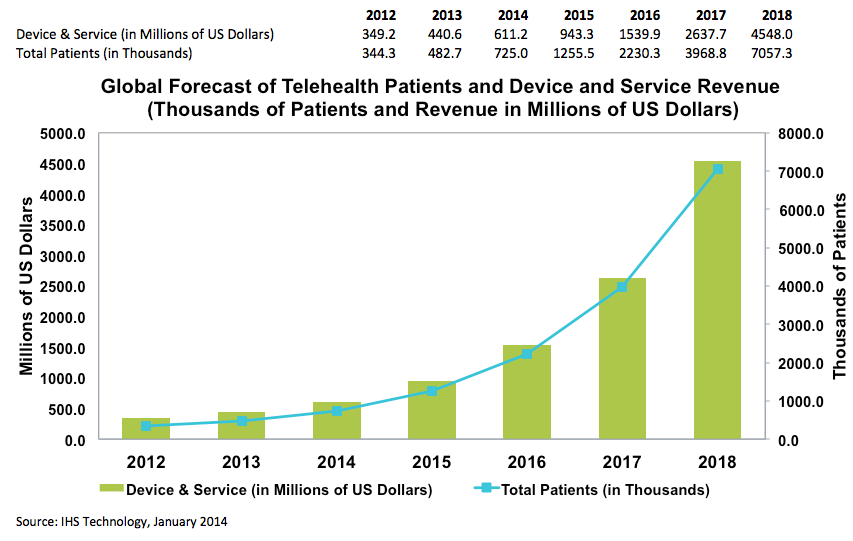Global Telehealth Market to Expand 10x by 2018
According to market research firm IHS Technology, the global telehealth market is expected to grow by more than a factor of 10 from 2013 to 2018, as medical providers increasingly employ remote communications and monitoring technology to reduce costs and improve the quality of care.

Worldwide revenue for telehealth devices and services is expected to swell to $4.5 billion in 2018, up from $440.6 million in 2013, based on data from an IHS report entitled “World Market for Telehealth – 2014 Edition.” The number of patients using telehealth services will rise to 7 million in 2018, up from less than 350,000 in 2013, as presented in the chart above.
Telehealth is defined as the use of medical devices and communication technology together to monitor diseases and symptoms. [EDITOR: Read our other articles on telehealth here.]
“Amid rising expenses, an aging population and the increasing prevalence of chronic diseases, the healthcare industry must change the way it operates,” said Roeen Roashan, medical devices and digital health analyst at IHS Technology. “Telehealth represents an attractive solution to these challenges, increasing the quality of care while reducing overall healthcare expenditures.”
Results from telehealth programs reveal sharp decreases in readmission rates and mortality rates, alongside increases in adherence through patient engagement. These benefits make a strong business case for telehealth and will result in greater reimbursement from regulatory bodies. As a result, providers will integrate telehealth into their healthcare delivery. In particular, the introduction of mobile health hubs is boosting the market, lowering the cost of telehealth while increasing overall value propositions.
Telehealth is especially helpful in managing the chronic conditions of those aged 65 and older – a group that constitutes a large percentage of the overall population – in the face of all-time-high levels of cardiovascular diseases, diabetes, cancer and obesity. Telehealth also offers scalable healthcare in a cost-efficient way at a time of increasing pressure on the healthcare sector for personnel and resources.
In Tech Adoption by Real Seniors 75+, Laurie Orlov observes that market research firms often cap their segmentation at 65+ to highlight the growing opportunities of aging baby boomers.
While telehealth mainly has been applied to post-acute patients, providers are now looking to monitor the health of entire populations. This process, called population health management (PMH), is further expanding the total available market for telehealth.
Other factors that will benefit the expansion of telehealth include the anticipated growth in wearable technology and the quantified self within a connected home context, aimed at developing a sustainable platform for preventive care.
# # # #
For more information, please contact: Jonathan Cassell, Senior Manager, Editorial
Direct: + 1 408 654 1714, Mobile: + 408 921 3754
My Advice as Editor of Modern Health Talk
If you buy any of these market research reports, make sure you get a chance to interview the authors personally to understand their assumptions, research process, and what shapes their conclusions. Make sure they aren’t just extrapolating trends but also include thoughtful discussion of market drivers, inhibitors and enablers, because you’ll need that insight to craft your strategies.
Do the authors understand what’s driving telehealth, including the ageing populations and resulting increase in chronic illness, environmental pollution, the availability of nutritious foods, rising care costs, and physician shortages? What do they think of obstacles posed by legal, privacy and security issues, payment models, medical school curriculum and funding? What impact will regulators and the political process have, either as driver or inhibitor? And what will be the short- and long-term impact of broadband Internet access and the exponentially accelerating pace of tech innovation? Consider how quickly Moore’s Law is finding its’ way into healthcare (https://www.mhealthtalk.com/moores-law-and-the-future-of-healthcare/) and ask what will likely happen as medical devices keep getting cheaper, smaller, more accurate, and easier to use.
Consider the impact of IBM Watson moving from physician assistance tool to advising and coaching consumers directly. How quickly will each of the medical functions done today by physicians in hospital & clinic settings safely move down-market to consumers at home? Won’t retail clinics and kiosks, and home doctor/nurse visits, just be stepping-stones along a path toward that eventuality?
And finally, what phases will the market projections go through, and when? What levers might you have to make projections happen more quickly? And what should you watch out for that could make them happen more slowly?

One Comment